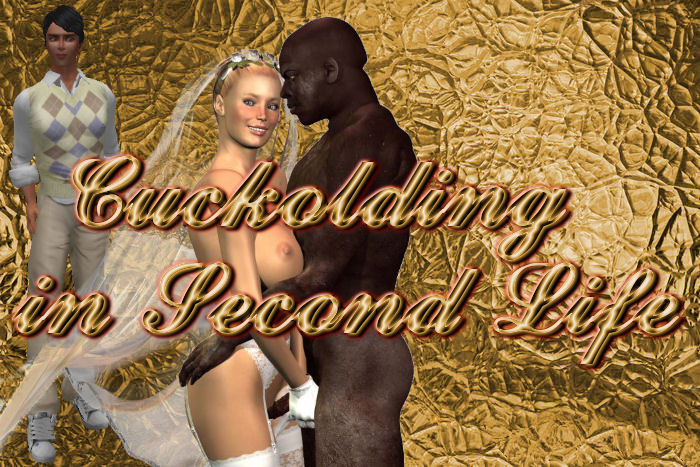Cuckoo for Cocoa Puffs
Keywords: cuckold, Cuckolding, Mark Pieterson
Cuckolding in porn and the colonial biopolitics behind it.

Pornography occupies an interesting position in the performative domain of cultural symbols, discourses, and archetypes; furthermore, the medium in which pornography is presented, either in video format or literary publications, structures what is being presented within a specific relational position (in relation to the viewer; i.e. the passive act of sitting in front of the medium and not interacting with the object in a tangible way) as to affect the desire of the viewer as far as its capacity to form a desirable reality. Of course, the nature of this desirable reality is comprised of a matrix of subjective dispositions of the viewer, for which pornography provides avenues for its expression.
Dialogues about pornography are vast as well as controversial and occur throughout history. Societies and cultures around the world grapple with the issue of the moral and ethical implications of pornography consumption. It has occupied religious, political, art, and academic spaces to varying degrees of opposition and support. Several analyses have been made to the impact of porn on the core institutions of society such as family, education, and law as well as specific members of societies such as women and children, especially when focus is placed on ethical considerations of labor in pornography and its exploitive capacity both of the body and cognition. These sort of considerations dominate the discourse of pornography with few analyses made on the autonomy and agency of pornography performers (as well as viewers), especially female performers, within the pornography industry as workers within this industry as well as the performative nature of pornography outside of contradictory value considerations and instead utilize the performance as a heuristic tool for analyzing and theorizing about modalities of desire and the gendered nature of sexual symbols. These sort of analyses allow the aesthetic presentation of pornography to not only highlight the autonomy and agency of the performers but also to deconstruct the dominant gendered sexual symbols from a space of imposed reality to a performative space where the power of these symbols to affect social discourses signify social relations only occur within that performative space.
I will attempt to analyze the performativity of cuckolding within porn in order to highlight and explain the symbols dictating its performative appeal and presentation by utilizing phenomenological considerations of the reflexive receptivity of the performance of cuckolding between both viewer and performers; socio-historical considerations of gender and its relation within a matrix of race, class, and sexual discourses. It is within the locus of cuckolding as a performative act within pornography that privileges it as a heuristic for analyzing conceptions of property, race, and the body that take place within the performative space since it draws largely on popular conceptions present in society that structure the way agents within society relate to beings and objects in the world.
At the same time that the cuckold performance is a reiteration of the phenomenological unity of husband and wife and the reiteration of trust via their autonomous or non-autonomous, partial or full, relinquishing of self-directed agency and freedom in the name of the ethical good of unionship (or any relationship of its essential nature), it also displaces this unity and related symbolic significations and orients it within a power structure that greatly emphasizes the autonomy and agency of one party over the other (male over female; husband over wife). Though the wife may exercise autonomous agency in satisfying her sexual desire while engaging in intercourse with her secondary “partner,” the sole purpose of her, as well as her partner’s, sexual satisfaction is to appease the sexual desire of her husband or primary partner.

Cuckold refers to a male with an adulterous wife or female partner. The etymology of the word is worth noting for its shift in the referent parties of the act of infidelity while at the same time maintaining the topological characteristic of the victim-antagonist power relationship. Cuckold derives from the “cuckoo” bird primarily because the female bird changes male mates frequently (which in a culture where female autonomy and control of the body is devalued, offers a link to how a negative affective value is ascribed to cuckolding on the part of the female and the male to relative degrees). Literary and iconographic evidence from the Medieval period use the word kukewold as a term for the male-partner victimized by the infidelity of the female-partner. The victimized male partner was often touted in the literature for having diminutive physical characteristics. Furthermore, the victimized male-partner was often portrayed as the reason for the occurrence of his partner’s infidelity by alluding to his inability to establish control, not only of his household, but the property he “owns” (of course this being his “female-partner,” children, and other possessions).
Chaucer and Shakespeare have both written of the shame cuckold brings onto a male in their respective works although all societies tend to have dispositions toward infidelity. Cuckold as a term is primarily used currently in the space of porn (and elsewhere) to mean a man who is both aware of and reconciled with his partner’s infidelity while at the same time gaining sexually motivated satisfaction from the situation. This relatively modern construction of the term, cuckold highlights a shift from the husband-as-victim to husband-as-orchestrator in the act of sexual infidelity; where the victimization serves to heighten the capacity for the aesthetic composition of the cuckold performance to induce sexual desire. In many porn films under the “cuckold” category, the male, usually husband or male-partner in a “serious” relationship, is often a passive or absent member in the sexual act, usually sitting or standing from a distance. He is usually recording the sexual act and often encouraging and or commanding his wife or female partner at random intervals. In essence his main purpose is to extract the surplus value of the sexual act that takes place for no other purpose besides motivating his own desire to copulate his wife.
The male engaging in intercourse with the female partner of the cuckold is usually an African-American male from a lower or equivalent socio-economic class with often used terms such as “ghetto,” “partner,” “Mandingo,” “gangbang,” or “bull” denoting their identity within the performative space. The cuckold and his wife or female-partner are almost always middle-class and Caucasian. The female is often passive (with respect to the situating of sexual desire) and characterized as a vesicle for the desires of not only her primary partner but secondary partner(s) as well. She is often referred to with such terms as “mature” or “mother,” signifying both her age and sexual experience. In many videos, the conclusion of intercourse is marked by the intentional ejaculation of the male of African descent, or at times the husband also, in the female’s vagina. This act alludes to the relationship between female infidelity and property-rights in that the act of insemination signifies a potential threat to the husband’s property and status since the child that results from the infidelity of the wife is legally not his and holds no right to the property of the man, which is viewed as shameful. The concluding act of insemination also highlights the signification of passivity commonly ascribed to the physical female body as a sexual tool devoid of autonomous agency as well as the signification of the lack of autonomy female agents have on the functions of their bodies (a discursive trend that is still prevalent in our current society) in several social institutions characterized by either implicit or explicit patriarchical symbols of social relationships between men and women especially men and women in de jure and de facto relationships of reflexive (or seemingly reflexive) desire or other reflexive intentions (i.e. de jure or de facto relationships with the intent of gaining, maintaining, or heightening economic potential or state appropriated benefits).

Sex with, and insemination by, a “bull” in a cuckold act serves to emphatically emphasize the threat posed on the husband in the event a child were to be conceived through insemination; for the stigma surrounding interracial relationships in a value system drawing from negative colonial racial dispositions. Whether or not any of the occurrences of insemination actually lead to the formation of a child is unknown though I infer that a significantly large number of insemination (commonly referred to by the term “creampie” in the linguistic community of pornography) do not lead to the formation of a child and only serves an aesthetic function within the context of the cuckold performance that both alludes to the association between the cuckold act and threats to the passage of property from father to kin and shape the affective response of desire for all parties involved (but most importantly the husband).
The terms used to signify the African-American male antagonist in the cuckold performance alludes to the construction of the African male body as aggressive (especially in scenes where multiple males of African descent are present and having intercourse with the female), sexually deviant, and exotic in the literature and iconography of the colonial era and successive generations. Paradoxically, the performance also reiterates the dubious cultural phenomena wherein the African male’s physical body signifies a positive signification in its capacity to perform sexually while at the same time reducing the subjectivity of the embodied subject to the sum of their physical bodies, which is partially stripped of autonomous agency (aside from their “will” to fulfill physical desires). The exotic nature of the negatively constructed African body within the colonial cognitive and discursive space allows the cuckold performance to maintain the status of the husband as the primary partner and positions the female as the primary property of the husband through the implicit performance of this relational framework with the symbolic disposition of the exclusivity of interracial relationships within a relational social system that stigmatizes female infidelity especially with “lower class” members of society (primarily males of African descent).
Both the female and the African-American male interestingly share a particular position within the cuckold performance in that the bodies of both are situated to invigorate the husband’s desire, albeit to varying degrees, and further, their bodies are reduced to the aesthetics of the active sexual functions of their external reproductive organs (the penis of the African American male is referred to as a “big black cock” or simply “BBC”). The African American male body and the female body can also be viewed as the property of the husband (the African American male can only be considered property when his body is present in the space for the cuckold performance; the wife is considered property by virtue of not only her presence in the physical performance space but also her de jure relationship with her primary partner) in that their roles and presence within the cuckold performance are a direct result of the husbands active exercise of paternalistic power. Furthermore, their bodies are situated as a direct object of the husband’s sexual desire.
This reduction in subjectivity to the automaton-like functions of the body eliminates consideration of self directed agency where, in this instance, pleasure is directed towards oneself alone in the sexual act or reciprocated towards only another individual depending on the dispositions of the agent; instead, pleasure towards oneself serves as only a means for the husband to satisfy his desires with very little labor thereby objectifying both the wife or partner and the other male. Interestingly enough, the viewer and the husband share very similar positions in the cuckold performance in terms of the situating of their desires and mode of expression and reception.
In the event the husband does join the sexual act that takes place, it is usually for a short duration and eventually returns to assume the neutral role in the cuckold performance. In many cuckold performances that the husband engages actively in the sexual act, his reduced status (his body is equivalent to the passive agency and autonomy characterized by the dominant construction of the female body in cultural discourse) that stems from the perceived social stigma resulting from his wife’s infidelity restructures his position as orchestrator to victim. In this instance, the female seems to adopt the role of protagonist of both pleasure and desire choosing to allow her husband to either join the sexual act to a certain degree (usually to please her and or her “bull” directly in a submissive role) or remain completely absent to stimulate his desire for copulation with his wife and or potentiate her own pleasure and desire by actively shaming her husband in the cuckold performance. The female does not necessarily become a “man” but actively utilizes her sexuality as a means to signify her agency and autonomy to a degree. Whereas the male relinquishes constructions of “manhood” that denote his identity as an adult male and instead is essentially “feminized”. This new construction of the male-body within the cuckold performance takes on dual and contradicting modalities: on the one hand, the male explicitly performs his feminized male body (i.e. cross-dressing, engaging in sexual acts with the “BBC,” or generally assuming an extremely submissive role) with no indication of “manliness”; on the other, he maintains his “manliness” and indications of his passive, feminized, body is restricted to the culturally mediated logical result of his wife’s infidelity that exists in the cuckold discourse.
The African-American male’s identity and role within the performative space of this particular cuckolding structure does not change as drastically as the wife or husband’s position. He still remains essentially passive as far as having autonomy within the cuckold performance, although this is not a universal characteristic within cuckold performances. There are moments where the African-American male seems to have some control of the direction of his desire and pleasure as well as the structure of the sexual act. However, these instances are few and more often than not, the main affective course of his agency lies in his autonomy to gain pleasure from having sex with the wife and or the husband in certain situations. Constructions of his agency and role in the cuckold performance remain in the framework of colonial constructions of the African male body.
The invisibility of the husband in certain films certainly obstructs considerations of agency of the female within the cuckold performance. It necessarily begs the question, which of these performers is actually in control as far as organizing and orchestrating this performance? Of course this can only be answered by an explicit denotation of the “controller” either in the title of the film or within the film itself. The viewer only has the performance to draw from for an inferential understanding of the structure of the performance but does not have direct access to the intentions of the performers themselves and so cannot accurately determine the subjective motivations of the performers.
Furthermore, the “invisibility” of the husband allows for two other constructions of his identity. First, it allows the viewer, who shares a relational role to the performance with the husband, to assume the situational role of the husband in the performance. Secondly, it allows the husband (and the viewer) to assume the symbolic role of a “benevolent…. post-patriarch” in the Foucauldian concept of biopolitics: his power lies not only in his ability to exercise direct control and authority at will, but also to benevolently and indirectly administrate authority and control over bodies. The husband, therefore, does not completely disappear from the symbolic matrix of the performance; his identity and presence only manifests itself differently (yet still essentially panoptic in nature) for the nature of the performance presupposes a consumption of the surplus affective value of the sexual performance by the husband very much in the same way his position as head-of-household in the conventional form and discourse of marriage presupposes his ability to extract the surplus value of the interrelations of his “property”. Unless, the situational role of the female shifts from passive body to active body and vice versa with respect to the husband. Identifying the “controller” or primary “initiator” of the cuckold performance is unnecessary for an analysis based strictly on the performance of culturally mediated symbols and identifying the position of the performance and symbols within a larger cultural discourse of the bodies of males and females in social relations.
For a cuckold performance to occur it seems there must exist some sort of an explicit and strong system of trust both husband and wife must have concerning the situating of their desires during the sexual performance of infidelity. It must be understood that the underlying consideration for the entire performance lies in the ability for the sexual performance to reinforce, through active performance, the desires both husband and wife have for each other in context of the structure of their relationship. This is a direct contradiction to the state of affairs that originates and constitutes the conceptual matrix of the term cuckold. The orientation of this relatively novel conceptual matrix most likely precedes the advent of internet pornography; nevertheless, it illustrates the capacity for performance to illuminate the values, symbols, and dominant discourses pertaining to the subjectivities of the body of males and females within a large or minute socio-historical frame (a frame that already undervalues individual or “fringe” experiences and agency).
Bibliography
G.W.F Hegel, Philosophy of Right (1820)
E. Cobham Brewer, Dictionary of Phrase and Fable (1898)
Geoffrey Chaucer, Canterbury Tales (1372-77)
William Shakespeare, Love’s Labour’s Lost (1588-1590)
Slavoj Žižek, Hegel on Marriage (2012)